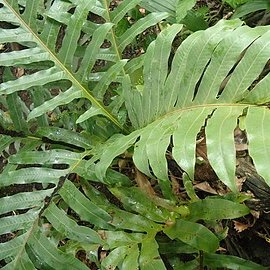Plants epiphytic, epilithic, or terrestrial. Rhizome shortly to long creeping; rhizome scales appressed or often squarrosely spreading, basifixed or peltate, margin toothed; fronds usually dimorphic, with basal and foliage frond, rarely monomorphic (basal frond absent); basal fronds sessile, orbicular to ovate-elliptic, entire to lobed up to 2/3; foliage fronds internally monomorphic or apical fertile part slightly narrowed, stalked, pinnatifid, apex often aborted, with a lateral pinna taking its place, rarely pinnate (then pinnae articulate to rachis, deciduous), hairs sometimes present, spread throughout lamina; in pinnatifid species, pinnae separating from costa and from each other by a line of abscission between costa and base of sinus; basal pinnae reduced; costae, costules, and main veins prominent abaxially, cross veins and minor venation evident, much anastomosing with occasional free included veinlets, veins forming glandular patches or nectaries along costa, usually just above costules; mature fronds without hydathodes on adaxial surface, margins cartilaginous, lamina of mature fronds scaly at first, glabrescent. Sori small, in rows along veins or connecting veins, very shallowly impressed. Sporangia glabrous or sometimes with glandular hairs. Spores with spines or small globules. n = 36, 37.
Rhizome creeping, branched, thick and fleshy, densely scaly; scale margins dentate or ciliate. Stipe not articulated to the rhizome. Fronds dimorphic: short sessile shallowly lobed sterile nest fronds (also called 'basal fronds' or 'scale fronds') which usually bear some stellate hairs or scales, soon becoming brown and papery and persisting for a long time, acting as humus collectors (sometime absent in terrestrial plants); and long pinnatifid or pinnate foliage fronds. Pinnae articulated to the rachis, or the whole of the lamina articulated down each side of the midrib (pinnatifid species); veins prominent, especially the ±parallel, but slightly zig-zag main veins, these connected by regular cross veins at ±right angles, forming areoles with smaller areoles within them, with very few free included veinlets; translucent nectaries on lamina of foliage and scale leaves and a conspicuous costular nectary often in pinna axils in pinnatifid species (in D. rigidula , borne on basiscopic edge of pinna stalk); nectaries active only in very young fronds. Sori round, rarely oblong to linear, at the angles of the small areoles of the foliage leaves. Spores ellipsoidal to reniform, pale to dark brown; surface smooth or echinate.
Separate short humus-collecting fronds present

